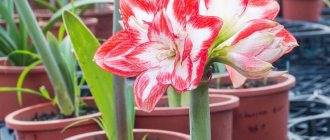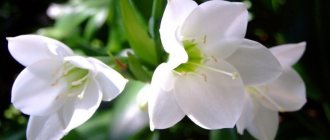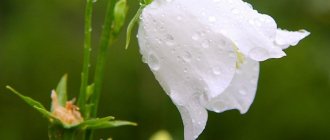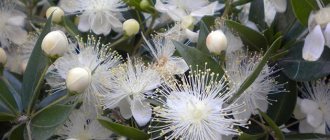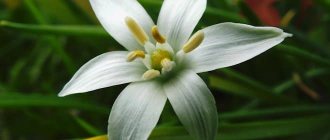Calibrachoa ampelous flower
The plant can feel good both in a pot and in the ground.
Calibrachoa ampelous loves light very much, be it a lamp or the sun, and is drawn to it. However, direct exposure to sunlight has a detrimental effect on the flower, especially in the heat of summer.
Flower close up
To properly care for the plant, you need to keep the flower in the sun only in the morning, when the sun's rays are not so strong. In the complete absence of sunlight, the flower fades.
Description of the Calibrachoa flower, or million bells
Ampelous viola or pansy - cultivation and care
The Calibrachoa ampelous flower became popular not so long ago. The bush itself is quite lush, with small bell flowers. The bud size is approximately 4 cm in diameter.
In the beginning, the plant had only one color - purple. Over time, other colors began to be developed, approximately similar to the rainbow (yellow, pink, white, blue).
Flower in a flowerpot
The length of the stem can reach more than 1 m. The spherical crown is covered with many small buds. They are very soft and pleasant to the touch, somewhat like silk.
For your information! Until 1990, the flower was considered a variety of petunia.
Description and features
Why this flower is called a million bells becomes clear at the first glance at the photo of calibrachoa . And at a second glance, doubts begin: is this not a petunia?
Indeed, until 1990, the plant was classified as a member of the large petunia family. However, during genetic studies of cultivated plants, initiated back in the eighties by the Austrian Society of Gardeners, it turned out that genetically these are completely different plants, although they are united by related origin. Petunia is simpler, it has only 14 chromosomal indicators, and calibrachoa has as many as 18.
The diameter of the Calibrachoa flower is from 1 to 3 cm, but their abundance creates the impression of a huge flowering cap, especially from a distance. The plant itself is not at all miniature - the branches, strewn with flowers, can reach a meter in length. And when planted in hanging flowerpots, the branches of some hybrid varieties reach one and a half meters.
The stems and leaves are quite hard and covered with fluff, however, to see them in the abundance of flowers of all shades and colors that you can imagine, you need to try very hard.
The popularity of these flowers is much higher than that of simple petunia, and with the advent of the Superbells species with double, incredibly fluffy, voluminous flowers of all shades, both mixed, striped and pure colors, calibrachoa has become simply unrivaled when decorating facades, flower beds, hedges or or just balconies.
In addition, this plant is a perennial, although, as a rule, gardeners limit the life of a bush to one year, dividing it into several plants and planting it in different flowerpots.
Growing Calibrachoa from Seeds
Ampelous pelargonium or geranium - growing and care at home
More recently, gardeners began to practice growing Calibrachoa ampelous flowers from seeds. Previously, only cuttings from the mother plant were used. This is due to the natural feature of the culture.
Note! At the moment, the market has begun to offer various varieties of hybrids that can be grown from seeds even at home. For example, calibrachoa ampelous Calita can be obtained with reduced cuttings.
Caring for seedlings obtained from seeds
It all depends on how to plant the seedlings. If the seeds were buried in peat tablets, picking does not need to be done. In the case of other planting options, picking and thinning are required.
After 3-4 weeks after germination, the seedlings are planted in separate containers. This process must be carried out with caution: lift the flower along with the ground and move it to the flowerpot.
Further caring for Calibrachoa ampelous involves feeding and watering. The bush is not able to tolerate too wet soil.
Note! The irrigation method should be used throughout the day.
In addition, in order for a flower to become a lush bush, you need to constantly pinch it.
Calibrachoa propagation methods
This beautiful representative of the flora can be propagated by cuttings and seeds.
But the second method is not effective due to the fact that
calibrachoas grown from seeds do not always convey varietal characteristics and may not bloom as profusely.
Photo of growing calibrachoa from seeds
Photo of calibrachoa seedlings from seeds
To propagate calibrachoa by cuttings, apical shoots 4 cm long are cut from an adult plant in the spring. Leaf plates are removed from the lower part of the shoots and immersed in moist, light soil. A transparent cap is placed on top to create greenhouse conditions. To remove excess moisture, the container must be lifted from time to time.
After rooting, calibrachoa cuttings are grown according to the principle of keeping indoor plants. Calibrachoa is unpretentious and can easily survive the winter, and again become a donor for reproduction in the spring.
Photos of calibrachoa cuttings
Caring for calibrachoa in the open field and at home
Fuchsia ampelous - description of varieties, cultivation and care at home
The main thing is the location. A flower can thrive satisfactorily not only in a flowerpot, but also in the ground.
Important! There is a certain nuance to growing a flower. Bright light from the sun in summer can easily ruin a flower; you need to be careful with it, because it is like silk.
The calibrachoa ampelous flower requires proper care: you need to make sure that it “bathes” in the sun’s rays in the morning and is in the shade during the daytime. If done incorrectly, this can lead to dullness of the flower.
Bushes can also be grown in flowerpots. For good growth, take 3-4 kg of soil per flower. The plant requires loose soil. The flower should have constant watering, but not very often. If it is too abundant, you can pour it in, and the calibrachoa will disappear.
Features of caring for calibrachoa in winter
The bush can survive the winter safely. When spring comes, the plant very quickly rehabilitates itself and begins to bloom.
There are various ways to store calibrachoa cuttings:
- In a refrigerator. This method is intended for gardeners who do not have a cellar and grow flowers on a sufficient scale. After the refrigerator, when the plant returns to its planting site, it will shed its shoots and begin to gain mass.
Watering
- In the basement. With the arrival of the first frosts in the fall, mature bushes are thrown away. To store in the basement, you need special conditions and a certain temperature (not lower than 10⁰C). The plant is stored until February.
- On the windowsill. If the first frost has already appeared outside, and the flower continues to bloom, in order to preserve it, you need to bring it into the house and place it on the windowsill and continue with your usual care.
For your information! In the conditions of Central Russia, it is very difficult for a bush to survive; it may not survive the winter. Basically, gardeners purchase cuttings in advance every new season.
Watering and humidity
Calibrachoa ampelous is quite sensitive to soil moisture. It should be watered only when the crust is dry. For proper watering, heated water in the sun is recommended. In summer you should water several times a day.
Important! When caring, the soil should always be slightly moist. This flower especially likes to be sprayed during the day.
Choosing a landing site
The bush can take root in the ground, at home on a loggia or on a windowsill on a balcony, the most important thing is that the windows face sunlight. At home, he will not be disturbed by weather elements that can harm him.
Flower on the balcony
Variety and popular varieties of Calibrachoa
A significant number of species of this plant are known. Some species of calibrachoa have managed to adapt to the climate of the central zone of the country. Just be patient and show a little diligence, and the gardener will become the happy owner of a gorgeous plant.
BEAUTIFUL FLOWERS!
Aquilegia Arabis (Rezuha) Subulate Phlox
Varieties in demand:
- "Kablum blue";
- "A Million Bells"
- Mini Famous Double Pink;
- Bells;
- Cabaret;
- Noa;
- Terry;
- Tequila.
Calibrachoa "Kablum blue"
The “Kablum blue” look can be said with confidence to be the most popular.
The second name of Kabloom Blue is hummingbird Kabloom Deep Blue.
This plant can be grown in open ground and indoor conditions.
It is easy to grow from seeds.
The varietal feature is the small height of the plant, only 35 cm.
The flowers are purple in color, with a yellow throat shaped like a rectangle. If you want to get this plant using the seed method, then you should start your plan in early March. Before sowing, it is recommended to soak the seeds in plain water without stimulants. The Kabloom species differs from others in its blue color.
All varieties of this group are the first results of breeders’ work with the calibrachoa plant.
Calibrachoa species "Million Bells"
The described species is the most famous and widespread.
Everything is explained simply - an expanded palette and an abundance of flowers.
If previously you could only enjoy the purple color, then “A Million Bells” will also delight you with blue and lilac colors. The seeds have rapid germination.
Useful article:
How to test seeds for germination
Shoots can reach 100 cm in length, which will be generously crowned with inflorescences. The “Million Bells” species has 18 varieties. They all vary in color: red, pink, cherry, bright yellow, crimson.
View Mini Famous Double Pink
The Mini Famous Double Pink species is distinguished by its double flowers.
The length of the shoots is relatively small, only 60 cm. But the size of the beautiful flowers is impressive - 3-4 cm.
The flowers amaze not only with their complex double shape, but also with all shades of pink. The Mini Famous Double Pink calibrachoa group is characterized by its fast rooting ability.
It is enough to dip the cuttings in a container with water, and after some time roots will form on them.
Calibrachoa Bells
The Bells species, which is in turn divided into 8 subspecies.
Inflorescences are formed on long shoots with a few bright green leaves. The color of the flowers can be yellow, red, orange, burgundy. The shoots are often pruned. Flowers on these plants appear early, in early May, and in large quantities.
The diameter of the flowers is 25-50 mm. To create a greater effect, this variety of calibrachoa is planted with white petunia.
Calibrachoa species Cabaret
The Cabaret variety includes 12 varieties from French and Dutch breeders.
Plants of the Cabaret variety with snow-white bell-shaped flowers look especially bright and catchy.
There are also varieties with delicate splashes of purple, pink and red. This species can grow very long shoots, up to 170 cm.
They need pruning.
The plant is often used to create flowering living supports, arches and when decorating festivals and celebrations.
Calibrachoa Noa
The Noa species can be considered the most elegant product of English breeders. There are 6 varieties, white, purple and other shades.
A distinctive feature of the species are the longitudinal lines on the elongated petals.
The length of the shoots sometimes exceeds 50 cm. The varieties can tolerate partial shade and slight waterlogging, but are distinguished by the capriciousness of the inflorescences.
It is not recommended to leave the plant in open ground over the winter, as this may affect the abundance of flowering.
The plant reproduces without problems by root division.
It can be grown in open ground, but it is better in special containers. But taking into account that calibrachoa is primarily a hanging plant, it is optimal to grow it in hanging pots.
Calibrachoa terry
The terry type of calibrachoa has another name: mini compact pink double.
Popular varieties of the species are “Compact Double”, “Double”, “Ellou”, “Double Pink”, “Double Rubi”, “Double Blue”.
A specific feature is the completeness of the inflorescence, where the corollas are multi-layered and full.
Photo of calibrachoa variety “Ellou”
Photo of Calibrachoa variety “Double Pink”
Photo of calibrachoa variety “Double Rubi”
Calibrachoa Tequila species
The Sunrise hybrid type of tequila is distinguished by the spectacular beauty of its abundant flowering. The buds quickly renew themselves and replace faded flowers. It is more often grown in containers than in open ground.
The volume of the bush can reach 40 cm in diameter.
How to prevent diseases and pests
If the plant is not properly cared for, various diseases can occur:
- black leg (too densely planted shoots);
- powdery mildew (humidity in the hot season, temperature changes);
- chlorosis (high calcium levels).
Blackleg can be identified by the softened part of the stems.
Powdery mildew is identified by the appearance of a white coating.
Chlorosis is visible by the unusual color of the leaves.
For your information! Insecticides intended for petunias will help get rid of ailments.
Bush formation
The bush needs to be trimmed periodically to maintain its beautiful shape. The first pruning is carried out after flowering, further pruning is carried out in the summer, shortening the shoots.
What is the difference between calibrachoa and petunia?
When considering different specimens (from a scientific point of view), the first difference is in the chromosomes. Petunia has four fewer chromosomes, but this does not stop gardeners from getting confused about the names.
There is one more difference. Calibrachoa ampelous has dense vines and the flower does not exceed a few centimeters in diameter; the quantity is compensated by its small size.
Calibrachoa ampelous from the outside looks like petunia, but with a detailed study of the stem it is possible to see the difference in diameter.
By planting calibrachoa, the gardener will receive a lush flowering ball, completely covered with bell flowers. You will have to tinker with the care, but the result is worth it!


